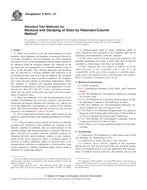Potřebujeme váš souhlas k využití jednotlivých dat, aby se vám mimo jiné mohly ukazovat informace týkající se vašich zájmů. Souhlas udělíte kliknutím na tlačítko „OK“.
ASTM D4015-07
Standard Test Methods for Modulus and Damping of Soils by Resonant-Column Method
Automaticky přeložený název:
Standardní zkušební metody pro modul a tlumení zemin metodou Resonant sloupec
NORMA vydána dne 1.9.2007
Informace o normě:
Označení normy: ASTM D4015-07
Poznámka: NEPLATNÁ
Datum vydání normy: 1.9.2007
Kód zboží: NS-25732
Počet stran: 23
Přibližná hmotnost: 69 g (0.15 liber)
Země: Americká technická norma
Kategorie: Technické normy ASTM
Anotace textu normy ASTM D4015-07 :
Keywords:
amplitude, confining pressure, damping, dynamic loading, elastic waves, elasticity modulus, frequency, laboratory tests, nondestructive tests, resonance, shear tests, soils, strain, stress, torsional oscillations, triaxial stress, vertical oscillations, vibrations, Young´s modulus, ICS Number Code 93.020 (Earth works. Excavations. Foundation construction. Underground works)
Doplňující informace
| Significance and Use | ||||||||||||||||||||||
|
The modulus and damping of a given soil, as measured by the resonant-column technique herein described, depend upon the strain amplitude of vibration, the ambient state of effective stress, and the void ratio of the soil, temperature, time, etc. Since the application and control of the ambient stresses and the void ratio are not prescribed in these methods, the applicability of the results to field conditions will depend on the degree to which the application and control of the ambient stresses and the void ratio, as well as other parameters such as soil structure, duplicate field conditions. The techniques used to simulate field conditions depend on many factors and it is up to the engineer to decide on which techniques apply to a given situation and soil type. |
||||||||||||||||||||||
| 1. Scope | ||||||||||||||||||||||
|
1.1 These test methods cover the determination of shear modulus, shear damping, rod modulus (commonly referred to as Young's modulus), and rod damping for solid cylindrical specimens of soil in the undisturbed and remolded conditions by vibration using the resonant column. The vibration of the specimen may be superposed on a controlled ambient state of stress in the specimen. The vibration apparatus and specimen may be enclosed in a triaxial chamber and subjected to an all-around pressure and axial load. In addition, the specimen may be subjected to other controlled conditions (for example, pore-water pressure, degree of saturation, temperature). These test methods of modulus and damping determination are considered nondestructive when the strain amplitudes of vibration are less than 104 rad (104 in./in.), and many measurements may be made on the same specimen and with various states of ambient stress. 1.2 These test methods cover only the determination of the modulus and damping, the necessary vibration, and specimen preparation procedures related to the vibration, etc., and do not cover the application, measurement, or control of the ambient stress. The latter procedures may be covered by, but are not limited to, Test Methods D 2166 or D 2850. 1.3 All recorded and calculated values shall conform to the guide for significant digits and rounding established in Practice D 6026. 1.3.1 The procedures used to specify how data are collected/recorded and calculated in this standard are regarded as the industry standard. In addition, they are representative of the significant digits that should generally be retained. The procedures used do not consider material variation, purpose for obtaining the data, special purpose studies, or any considerations for the users objectives; and it is common practice to increase or reduce significant digits of reported data to be commensurate with these considerations. It is beyond the scope of this standard to consider significant digits used in analysis methods for engineering design. 1.3.2 Measurements made to more significant digits or better sensitivity than specified in this standard shall not be regarded a nonconformance with this standard. 1.4 The values stated in SI units are to be regarded as the standard. Reporting test results in units other than SI shall be regarded as conformance with these test methods. This standard does not purport to address all of the safety concerns, if any, associated with its use. It is the responsibility of the user of this standard to establish appropriate safety and health practices and determine the applicability of regulatory limitations prior to use. |
||||||||||||||||||||||
| 2. Referenced Documents | ||||||||||||||||||||||
|




 Cookies
Cookies
